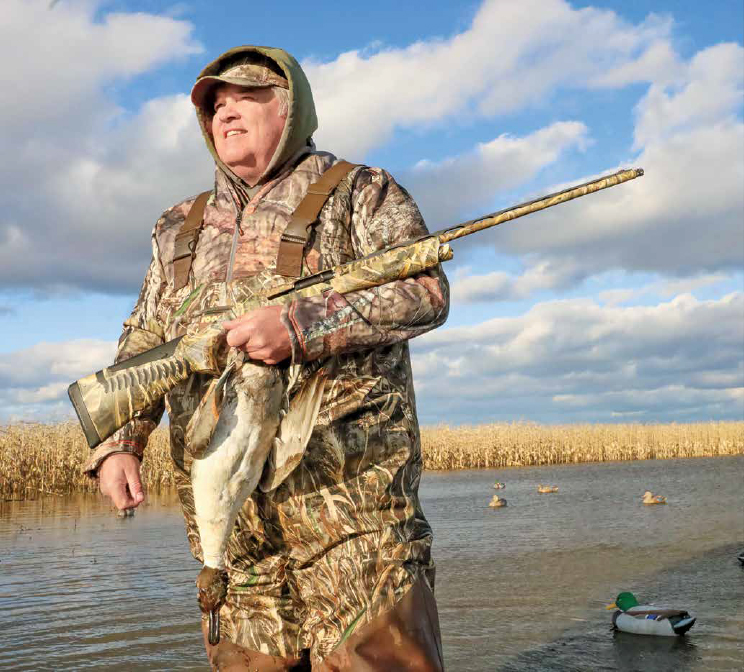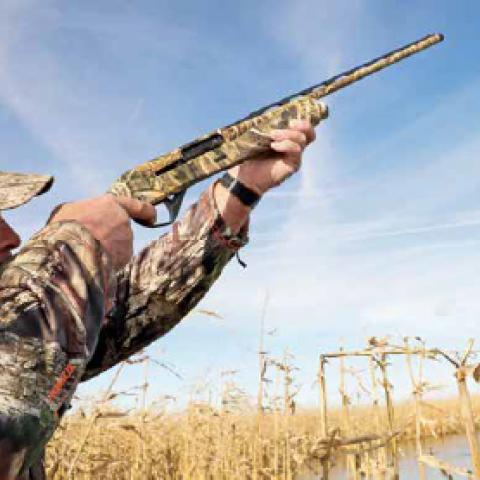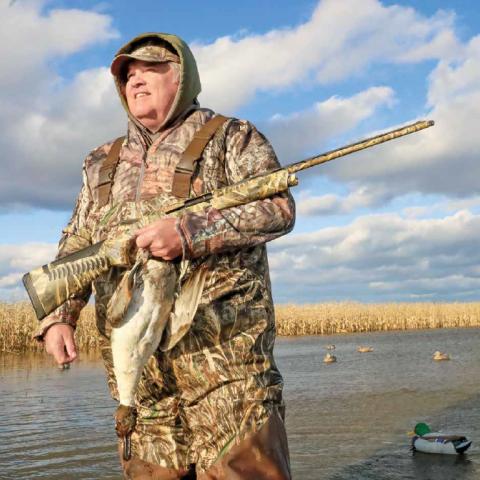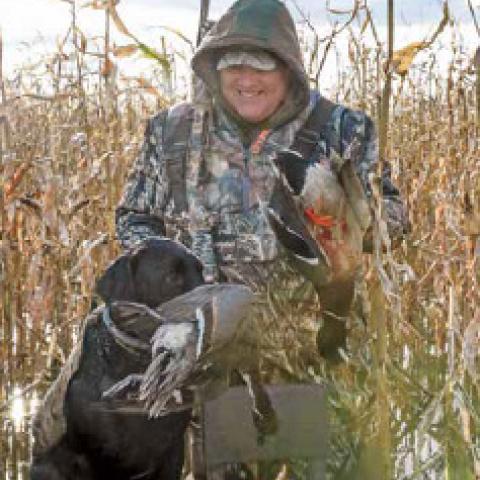LIGHT AS A FEATHER
BENELLI INTRODUCED the world to its inertia-driven shotguns in 1967. Bruno Civolani’s deceptively simple and reliable semiautomatic design has reshaped the shotgun market. Other firearm manufacturers have released their own inertia-operated semiauto shotguns in recent years, but Benelli enjoys a 50-year head start in this segment — the one they created. For 2022, the Italian company has created a whole new niche within the inertia-operated landscape. Let’s review the new Super Black Eagle III in 28 gauge.

Benelli’s flagship Super Black Eagle (SBE) shotgun has been honed to near perfection since 1992, and at the heart of this gun is Civolani’s inertia system. It consists of a rotating bolt head, a floating bolt body and a return spring. During recoil, the gun moves rearward, but the floating bolt body remains in position. The inertia spring is compressed and when the gun comes to rest after recoil, the spring unlocks the rotating bolt face and forces the bolt assembly rearward, extracting and ejecting the empty hull. A return spring in the gun’s stock then pushes the bolt forward and picks up the next shell from the carrier. The bolt head rotates, which locks the lugs, and the gun stands ready to fire again.
A benefit of the Benelli design is that gas and debris are expelled from the muzzle. Other gas-operated semiautos typically channel these gasses through the operating system; they often require more maintenance than Benelli’s Inertia-Driven guns. There are fewer moving parts to break on a Benelli, too, and inertia guns tend to be lighter than gas guns because of the simple operating system. Inertia guns are also light because they rely on the recoil stroke to operate, and lighter guns move more under recoil.
Benelli perfected the recipe for shotgun weight and spring tension on its 12-gauge SBE long ago. The 20-gauge SBE 3 (announced in the March 2021 issue of Guns & Ammo) and the new 28-gauge model required reconfigured springs for each gun’s weight. They also have uniquely scaled frames and mechanical parts. It was not easy; creating sub-gauge semiautomatics that function reliably is both costly and time-consuming. It’s one reason many semiauto shotguns are only offered in 12 gauge. The SBE 3 28-gauge is new, but Benelli isn’t new to 28-gauge shotguns. The company previously offered the semiauto Ultra Light, Ethos and Cordoba shotguns in 28 gauge. I’ve hunted with them all during the last decade and never had an issue with reliability. Benelli knows how to build 28s, and I’m glad to see the new SBE 3 offered in that gauge.
WHY 28 GAUGE?
The shotgun market has been evolving through the last decade, but so has shotgun ammunition. Traditionally, 28-gauge guns were offered with 23/4-inch chambers. The 28 was viewed as a “light duty” field weapon for hunting doves and quail and breaking clays. More importantly, no major shotgun manufacture was producing 28-gauge guns with 3-inch chambers — and no ammunition manufacturer was offering 3-inch 28-gauge shells. When Benelli began offering its Ethos in 28-gauge (2016), ammomaker Fiocchi (fiocchi.com) started loading 3-inch, 28-gauge shotshells, which expanded the 28’s potential.
Perhaps the most significant advancement in 28-gauge ballistics, however, was the development of Tungsten Super Shot (TSS) in 2006 by Hal Abbot. TSS is very dense — 18.3 grams per cubic centimeter (g/cc), as compared to lead at 11.3 g/cc. Smaller TSS pellets produce the same energy as larger lead pellets, but penetrate better because of a smaller surface size. As an example, TSS #9 pellets carry as much energy and penetrate deeper than #4 lead at the same velocity, and the smaller shot size means that there are more pellets per shot. The use of ultra-dense shot has greatly increased the effectiveness of all shotshells, and it has allowed the 28 to accomplish tasks once unimaginable for a sub-gauge — such as clean kills on turkey past 40 yards and dropping large ducks at the edge of a decoy spread. Benelli gets it, and that’s why it is now offering their flagship waterfowl gun in 28 gauge.
A CLOSER LOOK
I’m a long-time 28-gauge fan, and I was thrilled by the news of Benelli’s plans to offer an SBE 3 in 28. When one of Guns & Ammo’s test guns arrived, I wasn’t disappointed by the effort. The trim, reduced-scale aluminum receiver measured just 2.3-inches tall and 1.3-inches wide. The 12-gauge SBE 3, by contrast, has a receiver that measures 2.5-inches tall and 1.5-inches wide. While .2 inches may not seem like a lot, it makes a significant difference in how the gun handles and feels. On my scale, the 28-gauge weighed 5.6 pounds; the SBE 3 in 12-gauge with 3.-inch chamber weighed 7 pounds. The 28-gauge comes with an 8-inch- long forearm while the 12 sports a 9.-inch forearm. My only real complaint about this new gun is that the forearm was a bit short for me.
Aside from its scaled proportions, the 28-gauge SBE 3 is similar to the 12-gauge model. Both come with Benelli Crio barrels in either 26- or 28-inch lengths. Benelli’s Crio barrels are cryogenically cooled to -300 degrees Fahrenheit. This process relieves stress in the steel caused by hammer forging, but it also smooths the bore’s surface and makes cleaning easier. The SBE 3 also comes with three flush-fit Crio chokes (Improved Cylinder, Modified and Full) and extended IC and M Crio chokes. With the introduction of the SBE 3 in 12 gauge, Benelli added oversized controls; the 28-gauge has them, too.
Twenty-eights aren’t known as hard-kicking guns, but the SBE 3 has a stock featuring Comfort Tech 3 and Combtech, the same as 12- and 20-gauge versions. Comfort Tech 3 is a stock featuring a series of diagonally integrated shock-absorbing chevrons. The chevron size and layout is the same as found on the 20- and 12-gauge models. The Combtech is the cheek pad. It softens the recoil impact to the face, which is the primary cause of discomfort and can lead to flinching. Benelli’s system works well to dampen the 12-gauge version’s kick, so the 28-gauge gun barely produces any felt recoil, as you can imagine.
Like its 12-gauge stablemate, the 28-gauge SBE 3 features a carbon-fiber stepped rib, a red fiber-optic front sight and shim kit that allows the shooter to adjust cast and drop. The SBE 3 28-gauge’s receiver is not drilled and tapped, so the sights on the gun are what you have to work with. We attempted to mount an Aimpoint S-1 optic to the rib and found it to be too wide and tall to accept any of Aimpoint’s adapters.
The control layout is the same across the SBE 3 line. There’s an oversized bolt handle, a side-mounted bolt-release bar and a shell-drop button located on the right front of the triggerguard. The safety is a crossbolt positioned behind the triggerguard. There is no magazine cutoff since emptying the chamber simply requires pulling the bolt handle, which is a real bonus in the field, especially when you’re handling dogs. If you’d like to empty the magazine without cycling rounds, simply elevate the carrier and depress the shell stop located on the right rear of the magazine tube. Each press of the button drops a shell into the hand. Magazine capacity is three, but a plug limiter cuts that to two for waterfowl hunting. T
he SBE 3 in 28 gauge is available in either black or a choice of Mossy Oak Bottomland, Realtree MAX-5, or GORE Optifade Timber camo with barrel lengths of 26 or 28 inches. Models with a 26-inch barrel weigh an ounce less than those with 28-inch tubes. Overall lengths range from 471/2 to 491/2-inches, and length of pull is 14.375-inches. Retail for the black version is set at $1,799, while the camo model has an MSRP of $1,899. That’s more than Beretta’s gas-operated A400 Xplor Action in 28 gauge, which costs $1,599, but the Beretta doesn’t offer the Benelli’s 3-inch chamber or camo options.
ON THE RANGE
The SBE 3 28-gauge evaluation gun came dressed in Realtree MAX-5 camo with a 28-inch barrel. The gun’s unique balance point is immediately noticeable. Whereas most guns have a center-of-balance located near the front of the receiver, the 28 gauge’s balance point was at the rear of the ejection port. This biases the weight of the gun to the rear, making it easy to shoulder and swing with one hand. The non-shooting hand, then, directs the gun with a light grip, as it should be.
I found that the rearward bias was a benefit when shooting clays from a low-gun position. The shooting hand drives the gun to the shoulder while mounting, and the gun seats quickly into position.
For years, shotgun writers have called for a gun with forward balance to “smooth the swing” and prevent the gun from being “whippy.” But the SBE 3 in 28 comes effortlessly to the shoulder and tracks smoothly to the target. Having the weight in the rear also makes it easier for small-statured shooters to handle since they aren’t trying to manage excess forward gun weight, too.
With light loads, the SBE 3 was so soft-shooting that the recoil barely raised the front sight from the line of sight on crossing targets. The Benelli’s soft touch helped to smooth out the rough edges. Many shooters find that their scores at trap and skeet with a sub-gauge are similar to or better than scores with a 12-gauge. The reason? Your subconscious isn’t anticipating the thump of a 12 gauge, so you focus more intently on the target. Pick up an SBE 3 in 28 gauge and you may find that your clay scores and shots-per- dove average actually improve!
If the Benelli design has one weak point it’s that these guns require the bolt to be dropped with enough force to rotate the bolt head and engage the lugs. It’s only an issue if you ease the bolt forward instead of allowing spring pressure to do the work, but I can make the SBE 3 in 12-gauge stay out of battery when I lower the bolt carefully. I can’t do that with the new 28-gauge. No matter how gently I lowered the bolt into position, I simply couldn’t prevent the bolt head from rotating into position. The solution, of course, is to operate all these guns as they were intended and you won’t have an issue. The 28-gauge SBE 3 makes it impossible for the shooter to screw up. That also means you can gently lower the bolt in the duck blind or turkey woods without a lot of racket and still get the gun in battery.
Before I tested the gun at the range, I disassembled it, and cleaned and lubricated the internal surfaces. So long as the internal surfaces have a light coat of lubrication, Benelli shotguns will run without any hesitation through a range of loads, but the key word is “light.” Spraying gads of gun cleaner into the action has a deleterious effect on reliability, and it’s the cause of many “this thing doesn’t cycle right” calls to customer service. Once the gun was clean, lubed and reassembled, I shot clays with 28-gauge, .-ounce loads from Browning, Estate and Federal. In 75 rounds, there wasn’t one bauble. The trigger had some take-up, as you’d expect, but it fired after an average of 5 pounds, which is far better than other shotguns. Best of all during this test, I didn’t have the punch-drunk exhausted feeling I experience after a long day shooting 12-gauge guns.
IN THE FIELD
I hauled the SBE 3 in 28 to northern Ohio to meet with Outdoor Sportsman Group’s Jim McConville to hunt ducks in the marshlands surrounding Lake Erie. The weather cooperated and a cold north wind pushed ducks into our setup all day. McConville brought along several boxes of Federal’s Custom Shop Rob Roberts 28-gauge waterfowl load, which contains . ounce of #7 TSS shot driven at a velocity of 1,450 feet per second (fps). That’s a light load for big ducks, but McConville and I spent the day passing the Benelli back and forth and killing pintails, teal, mallards and black ducks without any problems. The 28-gauge is a precision tool, but more of a scalpel to the 12-gauge hammer. Still, we could kill birds at the edge of the Flambeau decoy spread, and there were very few cripples. I killed my first black duck when it cupped up directly in front of the dekes and coasted in to 25 yards. The force of the Federal TSS load hit the duck in the head and chest before it dropped lifeless from the sky.
If I had any doubts about the 28 gauge’s efficacy on large ducks, they were put to rest on Lake Erie. The 28 gauge doesn’t offer as much of a margin for error as a 3.-inch 12 gauge, but it will kill ducks efficiently and lacks the dizzying recoil of bigger magnums. I recorded film of McConville shooting Benelli’s 28 gauge, and you can see (or more correctly “not see”) the gun’s mild recoil with Federal’s relatively hot loads. I’m an ardent rabbit hunter, too, and I have been raising beagles since boyhood. While hunting cottontails isn’t considered particularly taxing, wading through black raspberry bushes, multiflora roses and cedars can scar gun stocks and finishes. The SBE 3 in 28 gauge was perfect for cottontail hunting because it’s light enough to carry for long miles. G&A’s camo-finished model survived the thorny gauntlet without a single blemish. What’s more, the gun can be loaded with 5⁄8- or 3/4-ounce shells, which is plenty for rabbits. I’ve seen cottontails disassembled when hit with 12 and even 20-gauge loads up close, but the Benelli rolled one crossing rabbit at 30 yards and killed another at half that distance without pureeing the meat of either animal.
What can’t the SBE 3 in 28 gauge do? The list is short. It wouldn’t be my choice for hunting large geese, and if I knew ducks would be hanging up all day at the far edge of a decoy spread, I’d probably carry my 12 gauge. If I were burning through hundreds of shells while shooting competitive sporting clays each week, I’d probably stick with the 12 gauge, too, since 12-gauge shells are more affordable and readily available. But the SBE 3 in 28 gauge would make a superb lightweight turkey gun when fed with TSS loads. It’s ideal for all flavors of upland game with the possible exception of spooky, hard-flying public land pheasants. Much of my upland hunting takes place on preserves anyway given that wild birds are scarce these days. A 28-gauge with heavy loads would be plenty for released quail, chukar and pheasant.
There’s a stream behind my home that draws in wood ducks each fall. The SBE 3 in 28 gauge is ideal for just that type of hunting. Passing mallards that arrive late in the season aren’t safe with the right load. The 28 gauge is also perfect for small-statured and recoil-sensitive shooters. I have a young son and daughter who may want to shoot someday, which is why I’ve decided to purchase a Benelli SBE 3 following this review. (At least, that’s why I’m telling my wife I bought it.) Once upon a time, I believed serious shotgunners needed at least two guns: A 12-gauge catch-all repeater and a light 20-gauge field gun. I still think every gun safe should hold at least one 12 gauge, but Benelli has made me a believer. The ultimate lightweight scattergun is now a semiauto 28-gauge called the “SBE 3.” Ammo has reimagined what the 28 gauge can accomplish, and the SBE 3 is now a part of that.
Content courtesy of Outdoor Sportsman's Group





